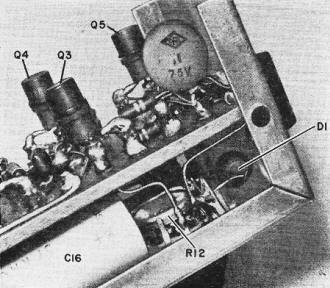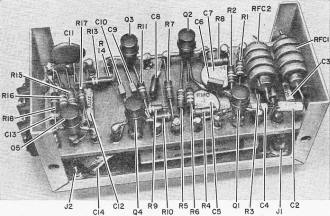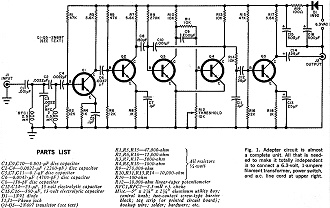Simple Subsidiary Communications Authorization (SCA) Adapter
|
|
Unlike Radio Broadcast Data System (RBDS) which is responsible for your FM radio being able to display song title and station identification via a digital subchannel (began in 1992), Subsidiary Communications Authorization (SCA) has been around as an analog subchannel for more than half a century. SCA (was) used for tasks such as book reading for the blind, telemetry, paging services, and most familiarly - Muzak (aka "elevator music"). This article presents a simple circuit for stripping the subcarrier off of the FM broadcast signal to permit a listener to avoid commercials, PSAs, weather reports, and other items that are played between songs. Personally, I'll endure the commercials and weather reports but would like to be able to block songs I can't stand. Note the 6.3 VAC supply requirement, which is obviously a remnant from the readily available vacuum tube heater voltage transformers that were on their way out of common use. Simple SCA Adapter
By William F. Splichal, Jr. Many FM broadcast stations transmit a secondary frequency-modulated subcarrier that is offset from the regular carrier frequency by 67.5 kHz. This sub-carrier channel (called SCA for Subsidiary Communications Authorization) provides the listener with continuous music programming that is uninterrupted by commercials, news, weather, or other reports. The SCA should not be confused with the 38-kHz subcarrier normally used to carry the complementary channel in normal stereo FM broadcasts; it is a separate system which no home entertainment receiver is designed to receive. Perhaps you are already familiar with the SCA broadcasts. You hear them in such places as restaurants, supermarkets, and other commercial establishments as "background" music. If you would like to receive the SCA subcarrier with your present receiver, all you need is a simple multiplex adapter that can extract the program material without interference from the "normal" program channel transmissions from the FM station. Adding the SCA Adapter (described in this article) to your FM receiver will in no way interfere with the receiver's normal operation. If anything, it will add to the receiver's versatility by providing an extra source of entertaining music. How It Works. Referring to Fig. 1, the frequency-modulated SCA subcarrier is introduced into the adapter through input jack J1 where it encounters a 67.5-kHz parallel-tuned circuit consisting of radio frequency choke RFC1 and capacitor C3. Then it is passed through a high-pass filter made up of C2, C4, and RFC2. From here, the frequency-modulated sub-carrier is amplified and limited by Q1 and Q2, respectively. At this point, the frequency modulation will have been converted to a series of pulses whose frequency is the same as that of the original frequency modulation. Once amplified and limited, the signal is coupled to monostable multi vibrator stage Q3-Q4. Here, Q3 is normally conducting, while Q4 is held in cutoff. Potentiometer R12 acts as a "threshold" control, allowing only the higher amplitude 67.5-kHz subcarrier signals to trigger the multivibrator. Each time the multivibrator fires, a negative pulse is generated at the collector of Q4. Since the width of the generated pulse is essentially independent of the triggering rate, the average voltage level appearing at the collector of Q4 will be directly proportional to the triggering frequency (the 67.5-kHz modulation up to the point where Q4 is cut off completely all the time. This point is slightly above the audio spectrum; therefore, the multivibrator will deliver an output for the full subcarrier modulation range.
Although the SCA Adapter so far described makes use of five commonly available npn silicon transistors, germanium or pnp transistors can be substituted. Merely change the polarities or values of a few components. The changes that must be made for transistor substitutions are given in the table on the next page. Construction. The circuit of the SCA Adapter is really very simple, lending itself to just about any type of chassis construction you prefer. While the photos show the original prototype assembled on a double-row solder-terminal tag strip, which is essentially point-to-point wiring, a printed circuit board layout would have been just as appropriate for assembly. The circuit can be assembled in any enclosure you choose. A 5" X 2 1/4" X 2 1/4" aluminum utility box was used for the prototype, with J1 and J2 mounted at opposite ends of the top surface. Threshold control R12 was also mounted to the top, while to one side is located a screw-type barrier block for bringing in the 6.3 volts a.c. for the power supply circuit. Transistors can be installed in sockets or soldered directly to lugs. Locate a.c. filter capacitors on underside of terminal board and the barrier block at end of box. Although a printed circuit board or multi-lug terminal strips could be used, wiring is just as simple with a parallel-row terminal board having 13 solder lugs per row as shown here. Installation and Use. To operate properly, the SCA adapter must be electrically connected to your receiver. This is a simple process that can be performed in a couple of minutes. Before digging into your receiver (or tuner), carefully study its schematic diagram to locate the detector stage and resistor/capacitor de-emphasis network. Then, study the receiver layout to locate the point indicated in Fig. 2. You will notice that the SCA Adapter's input must be connected to a point between the detector output and the de-emphasis network. If the connection is made after the de-emphasis network, no SCA signal will pass through! The filter (SCA Adapter) was designed to operate most efficiently with a 3000-ohm load. So, it may be necessary to couple the adapter to the receiver circuit via an isolation resistor with a value of a few thousand ohms, depending on your particular receiver. Simple Subsidiary Communications Authorization (SCA) Adapter Schematic Fig. 1 - Adapter circuit is almost a complete unit. All that is needed to make it totally independent is to connect a 6.3-volt, 1-ampere filament transformer, power switch, and a.c. line cord at upper right. Now, connect a twisted-pair cable between the 6.3-volt a.c. winding on your receiver's power transformer and the screw-type barrier block on the adapter. If 6.3 volts a.c. is not available from your receiver, use a separate 6.3-volt filament transformer. Then connect a shielded audio cable from the adapter's output jack to the auxiliary (AUX) input jack on the rear apron of your receiver. Turn on and tune the receiver to a local FM station known to be broadcasting SCA program material. Set the receiver's source switch to AUX and function switch to MONO, and adjust threshold for the clearest audio. (Note: in some receivers, when the source switch is moved out of the TUNER or FM position, the power is disconnected from the tuner. In this case, connecting the output of the adapter to the receiver's AUX in-put will not work - a separate amplifier will be required unless you can figure a way of restoring power to the tuner when the source switch is in the AUX position. Tuning across the dial, you may find that several SCA programs are available. This is true especially in the large cities where different types of background music are required by the subscribers. So much the better for your choice of programs. A Note About the Law There is no FCC Regulation that prohibits the reception of Subsidiary Communications Authorization broadcasts for private home entertainment purposes. However, there are regulations that do prohibit the use of SCA programs to promote business (or any other reason) by commercial establishments unless such businesses are authorized subscribers and use only the SCA channel to which they subscribe.
Posted March 13, 2024 |
|

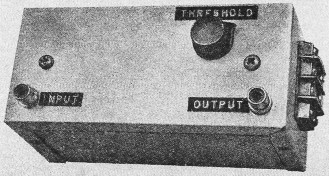 FM Music Sans Commercials
FM Music Sans Commercials 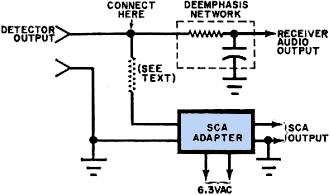
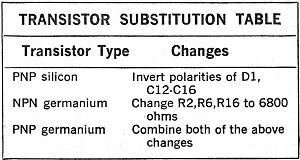 Power for the SCA adapter is derived from any
6.3-volt, 60-Hz, source. A built-in half-wave rectifier/filtering circuit, consisting
of D1 and C15, C16 and R19, provide the d.c. voltage required for proper operation
of the adapter.
Power for the SCA adapter is derived from any
6.3-volt, 60-Hz, source. A built-in half-wave rectifier/filtering circuit, consisting
of D1 and C15, C16 and R19, provide the d.c. voltage required for proper operation
of the adapter. 